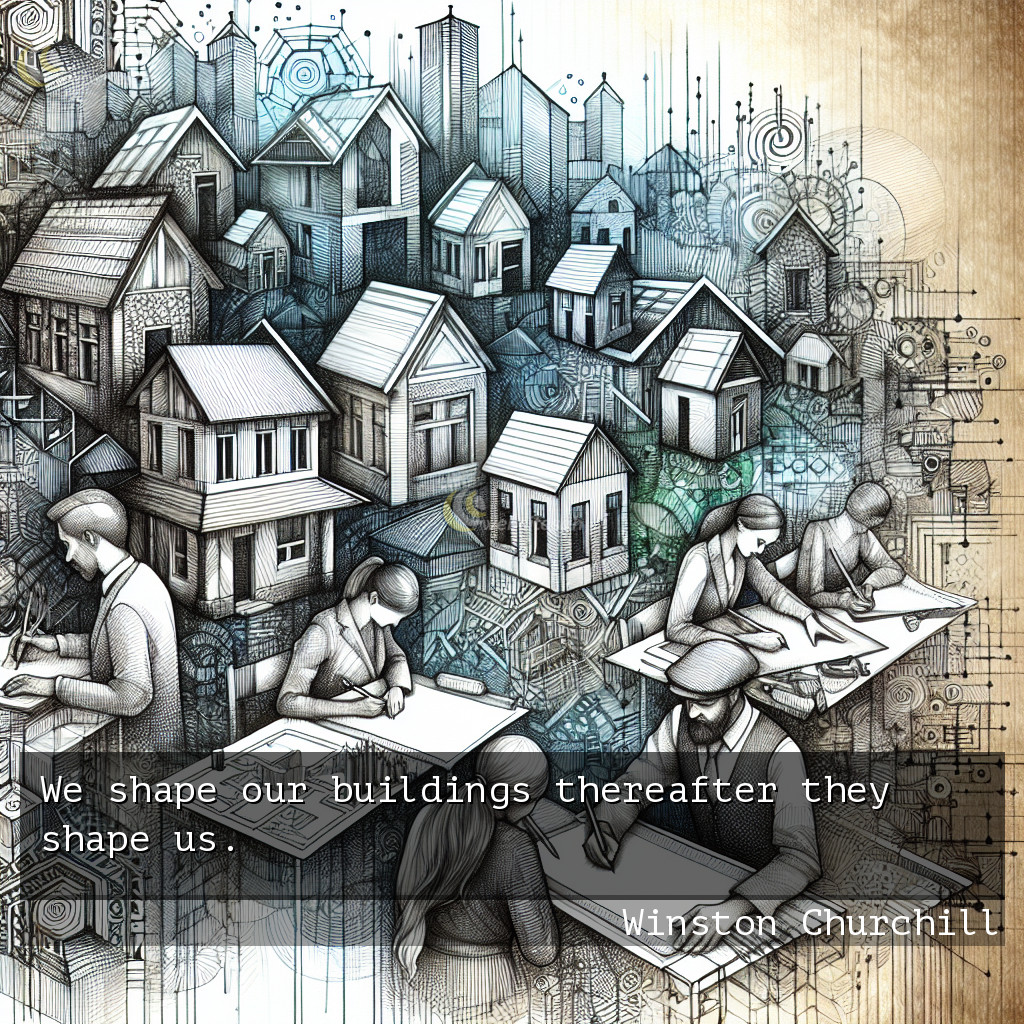This website uses cookies so that we can provide you with the best user experience possible. Cookie information is stored in your browser and performs functions such as recognising you when you return to our website and helping our team to understand which sections of the website you find most interesting and useful.

Winston Churchill quotes on Architecture

Winston Churchill quotes on Architecture
We shape our buildings thereafter they shape us.
By: Winston Churchill
Imagine standing before a grand, towering structure, its silhouette casting a long shadow that stretches across the bustling streets. This building, with its intricate design and imposing presence, is not just a mass of concrete and steel. It’s a testament to human ingenuity, a canvas where our collective aspirations are etched in stone and glass. The quote “We shape our buildings; thereafter they shape us,” attributed to Winston Churchill, encapsulates a profound truth about the symbiotic relationship between humans and their creations. It’s a dance of influence, where our environment molds our thoughts, behaviors, and ultimately, our destiny.
The Power of Environment
Our surroundings have a subtle, yet powerful impact on our lives. From the homes we live in to the schools we attend, each space holds the potential to inspire or constrain. A room flooded with natural light can lift our spirits and ignite creativity, while a cramped, dimly lit space might dampen our enthusiasm and stifle our productivity. It’s in these crafted spaces that we find joy, face challenges, and grow. They are the silent witnesses to our lives, echoing our laughter and absorbing our tears.
Designing for Happiness
When architects and designers embark on creating a new structure, they are not merely drafting a building; they are sculpting the backdrop of human experience. A well-designed space can foster community, encourage learning, and promote well-being. Consider the layout of a school: wide corridors encourage interaction, open spaces invite students to congregate, and classrooms designed with attention to acoustics enhance learning. These elements don’t just make for an aesthetically pleasing building; they shape the daily experiences of the students, influencing their social dynamics and academic performance.
The Echo of Architecture in Our Lives
Just as a potter shapes clay into a vase, the spaces we inhabit shape our routines, habits, and interactions. A home with a large kitchen table might become the heart of family life, a place where meals are shared, and conversations flow. An office with a variety of workspaces can cater to different moods and tasks, allowing employees to find their ideal spot for concentration or collaboration. These are not just passive settings; they are active participants in the narrative of our lives.
Building a Better Self
Understanding the impact of our environment can empower us to make changes that enhance our lives. Small adjustments to our living or workspaces can have profound effects. Adding plants, reorganizing furniture to create open areas, or simply changing the color of a wall can transform the feel of a room. As we shape our spaces to reflect our needs and desires, we create an atmosphere that supports our growth and happiness.
Embracing Change
Just as buildings evolve over time, with renovations and restorations adapting them to new purposes, we too are works in progress. Embracing the idea that we are influenced by our surroundings can inspire us to seek out environments that align with our aspirations. Whether it’s finding a quiet corner in a library, joining a vibrant community center, or simply rearranging our living space, we have the power to shape our settings in ways that nurture our development.
Conclusion: The Blueprint of Life
Churchill’s insight reminds us that our relationship with the built environment is a dynamic exchange. We are both the architects of our spaces and the clay molded by the hands of our creations. By recognizing this interplay, we can approach our lives with intention, crafting surroundings that not only reflect who we are but also who we wish to become. So, let us take up the tools of our imagination and build not just buildings, but lives that are full of purpose, joy, and meaning.
FAQs about Winston Churchill on Architecture
- What did Winston Churchill mean by “We shape our buildings; thereafter they shape us”?
Churchill meant that the design and structure of the buildings we create have a significant impact on our behavior, feelings, and overall well-being. Initially, we design buildings to serve our needs, but once they are built, they influence how we live, work, and interact with others.
- How can architecture influence our daily lives?
Architecture can influence our daily lives by affecting our mood, productivity, social interactions, and even our health. The layout, lighting, acoustics, and aesthetics of a space can all contribute to how we feel and behave within it.
- Can changing our environment really improve our well-being?
Yes, changing our environment can significantly improve our well-being. Alterations such as increasing natural light, adding greenery, or creating open spaces can enhance our mood, reduce stress, and promote a more positive outlook on life.
- Why is it important for schools to be well-designed?
Well-designed schools are important because they provide an environment conducive to learning and development. Factors like natural lighting, noise control, and comfortable spaces can improve concentration, encourage collaboration, and support the educational needs of students.
- What role does architecture play in shaping our behavior?
Architecture plays a significant role in shaping our behavior by defining the spaces where we live and work. The design of a building can dictate traffic flow, encourage certain activities, and even influence our social interactions.
- How can we use Churchill’s quote to improve our personal spaces?
We can use Churchill’s quote as inspiration to make conscious choices about our personal spaces. By understanding how our environment affects us, we can create spaces that are more harmonious with our lifestyle and goals, thus improving our quality of life.
- Is there a connection between architecture and mental health?
Yes, there is a strong connection between architecture and mental health. Spaces that are well-lit, have good air quality, and offer access to nature can reduce stress and anxiety, while poorly designed spaces can have the opposite effect.
- Can the design of a building influence community and social life?
Absolutely. The design of a building can greatly influence community and social life by providing spaces that encourage people to gather, interact, and build relationships. Community centers, parks, and public squares are examples of architectural spaces that promote social cohesion.
- How can workplaces be designed to improve employee productivity?
Workplaces can be designed to improve employee productivity by incorporating elements such as ergonomic furniture, natural light, quiet zones for focused work, and communal areas for collaboration. A well-designed workplace can boost morale and efficiency.
- What can individuals do to make their living spaces more conducive to their needs?
Individuals can make their living spaces more conducive to their needs by personalizing their environment to suit their preferences. This can include rearranging furniture, decluttering, adding personal touches like artwork or plants, and ensuring there is adequate lighting and comfort.





















